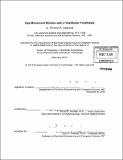| dc.contributor.advisor | Daniel M. Merfeld. | en_US |
| dc.contributor.author | Saginaw, Michael A. (Michael Adlai) | en_US |
| dc.contributor.other | Massachusetts Institute of Technology. Dept. of Electrical Engineering and Computer Science. | en_US |
| dc.date.accessioned | 2010-08-30T14:32:17Z | |
| dc.date.available | 2010-08-30T14:32:17Z | |
| dc.date.copyright | 2010 | en_US |
| dc.date.issued | 2010 | en_US |
| dc.identifier.uri | http://hdl.handle.net/1721.1/57680 | |
| dc.description | Thesis (Ph. D.)--Massachusetts Institute of Technology, Dept. of Electrical Engineering and Computer Science, 2010. | en_US |
| dc.description | Cataloged from PDF version of thesis. | en_US |
| dc.description | Includes bibliographical references. | en_US |
| dc.description.abstract | Vestibular loss, which can manifest as dizziness, imbalance, or spatial disorientation, is widespread and often caused by inner ear hair cell malfunction. To address these problems, we are developing a vestibular implant analogous to cochlear implants for the deaf. This vestibular prosthesis provides pulsatile electrical stimulation to the vestibular nerve. Prosthesis effectiveness is assessed using the vestibulo-ocular reflex (VOR), since the VOR helps stabilize gaze in healthy individuals by evoking eye movements that compensate for head movements. In this thesis, the prosthesis was used to probe the high frequency VOR in squirrel monkeys and guinea pigs. In two studies, modulated stimulation was applied acutely to characterize the VOR between 1.5 and 701 Hz. A third study characterized the VOR response to chronic stimulation with a constant rate of 250 Hz. The VOR has previously been characterized up to 50 Hz in monkeys and 2 Hz in guinea pigs by physically rotating subjects. This range was extended in these studies, by using electrical stimulation from the prosthesis. Eye movement spectral peaks were used to characterize the VOR frequency response. The VOR was measurable up to 267 Hz in squirrel monkeys and 151 Hz in guinea pigs. The magnitude response was similar in both species - it increased gradually with frequency, peaked (at 140 Hz in squirrel monkeys and 50 Hz in guinea pigs), and then rolled off. | en_US |
| dc.description.abstract | (cont.) The high frequency fall-off was consistent with the low-pass nature of the oculomotor plant. The phase responses had a linear lag with frequency, consistent with a fixed 4 ms delay of the VOR three-neuronarc. Since the VOR responds at high frequencies, this raises the question whether the prosthesis causes eye movements at the prosthesis pulse rate, since electrical stimulation elicits neural responses that are phase-locked with the stimulation. Such responses might cause visual blurring for a patient using the device. This thesis shows that such eye movements are measurable, and have substantial velocity magnitude of 8.1 deg/s initially, but within 30 minutes the magnitude reduces by 80% and probably does not yield perceptible visual blurring. | en_US |
| dc.description.statementofresponsibility | by Michael A. Saginaw. | en_US |
| dc.format.extent | 59 p. | en_US |
| dc.language.iso | eng | en_US |
| dc.publisher | Massachusetts Institute of Technology | en_US |
| dc.rights | M.I.T. theses are protected by
copyright. They may be viewed from this source for any purpose, but
reproduction or distribution in any format is prohibited without written
permission. See provided URL for inquiries about permission. | en_US |
| dc.rights.uri | http://dspace.mit.edu/handle/1721.1/7582 | en_US |
| dc.subject | Electrical Engineering and Computer Science. | en_US |
| dc.title | Eye movement studies with a vestibular prosthesis/ | en_US |
| dc.type | Thesis | en_US |
| dc.description.degree | Ph.D. | en_US |
| dc.contributor.department | Massachusetts Institute of Technology. Department of Electrical Engineering and Computer Science | |
| dc.identifier.oclc | 635453341 | en_US |
